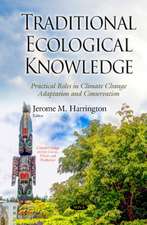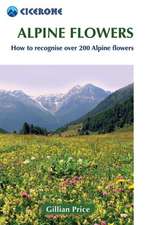The Ecological Basis of Conservation: Heterogeneity, Ecosystems, and Biodiversity
Autor Steward Pickett, Richard S. Ostfeld, Moshe Shachak, Gene E. Likensen Limba Engleză Hardback – 31 ian 1997
| Toate formatele și edițiile | Preț | Express |
|---|---|---|
| Paperback (1) | 1008.12 lei 6-8 săpt. | |
| Springer Us – 5 noi 2012 | 1008.12 lei 6-8 săpt. | |
| Hardback (1) | 956.81 lei 6-8 săpt. | |
| Springer Us – 31 ian 1997 | 956.81 lei 6-8 săpt. |
Preț: 956.81 lei
Preț vechi: 1166.84 lei
-18% Nou
Puncte Express: 1435
Preț estimativ în valută:
183.09€ • 191.55$ • 152.09£
183.09€ • 191.55$ • 152.09£
Carte tipărită la comandă
Livrare economică 02-16 aprilie
Preluare comenzi: 021 569.72.76
Specificații
ISBN-13: 9780412098512
ISBN-10: 0412098512
Pagini: 466
Ilustrații: XXI, 466 p.
Dimensiuni: 155 x 235 x 30 mm
Greutate: 0.77 kg
Ediția:1997
Editura: Springer Us
Colecția Springer
Locul publicării:New York, NY, United States
ISBN-10: 0412098512
Pagini: 466
Ilustrații: XXI, 466 p.
Dimensiuni: 155 x 235 x 30 mm
Greutate: 0.77 kg
Ediția:1997
Editura: Springer Us
Colecția Springer
Locul publicării:New York, NY, United States
Public țintă
ResearchCuprins
I. Introduction: The Needs for a Comprehensive Conservation Theory.- 1. Defining the Scientific Issues.- 2. Part 1. Gretchen Long Glickman—Science, Conservation, Policy, and the Public.- 2. H. Ronald Pulliam—Providing the Scientific Information that Conservation Practitioners Need.- 3. Michael J. Bean—A Policy Perspective on Biodiversity Protection and Ecosystem Management.- 3. Conservation and Human Population Growth: What are the Linkages?.- 4. Developing an Analytical Context for Multispecies Conservation Planning.- 5. Operationalizing Ecology under a New Paradigm: An African Perspective.- II. Foundations for a Comprehensive Conservation Theory.- Themes.- 6. The Paradigm Shift in Ecology and Its Implications for Conservation.- 7. The Emerging Role of Patchiness in Conservation Biology.- 8. Linking Ecological Understanding and Application: Patchiness in a Dryland System.- III. Biodiversity and Its Ecological Linkages.- Themes.- 9. The Evaluation of Biodiversity as a Target for Conservation.- 10. Conserving Ecosystem Function.- 11. The Relationship between Patchiness and Biodiversity in Terrestrial Systems.- 12. Reevaluating the Use of Models to Predict the Consequences of Habitat Loss and Fragmentation.- 13. Managing for Heterogeneity and Complexity on Dynamic Landscapes.- 14. Toward a Resolution of Conflicting Paradigms.- 15. The Land Ethic of Aldo Leopold.- IV. Toward a New Conservation Theory.- Themes.- 16. The Future of Conservation Biology: What’s a Geneticist to Do?.- 17. Habitat Destruction and Metapopulation Dynamics.- 18. How Viable is Population Viability Analysis?.- 19. Reserve Design and the New Conservation Theory.- 20. Ecosystem Processes and the New Conservation Theory.- 21. Measurement Scales and Ecosystem Management.- 22. BiogeographicApproaches and the New Conservation Biology.- 23. Conserving Interaction Biodiversity.- V. The Application of Conservation Ecology.- Themes.- 24. State-Dependent Decision Analysis for Conservation Biology.- 25. Expanding Scientific Research Programs to Address Conservation Challenges in Freshwater Ecosystems.- 26. Standard Scientific Procedures for Implementing Ecosystem Management on Public Lands.- 27. Whatever It Takes for Conservation: The Case for Alternatives Analysis.- 28. Conservation Activism: A Proper Role for Academics?.- 29. Getting Ecological Paradigms into the Political Debate: Or Will the Messenger Be Shot?.- VI. Synthesis and a Forward Look.- Themes.- 30. A Summary of the Sixth Cary Conference.- 31. The Linkages between Ecology and Conservation.- 32. The Central Scientific Challenge for Conservation Biology.- 33. Toward a Comprehensive Conservation Theory.- Epilogue: A Vision of the Future.
Recenzii
`... this book is of great value for anyone interested in ecology or conservation science. It should be on the bookshelves of many libraries at universities, research institutes, management planning agencies to give the opportunity for regular consultation.'
Abstracta Botanica, 22 (199)
Abstracta Botanica, 22 (199)











